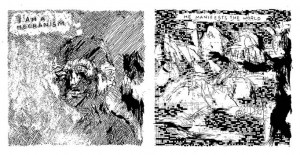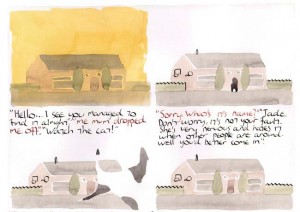Best Webcomics of 2010

Since webcomics are the only type of comic I’m reading in a regular serial form (not counting long term projects like Rusty Brown or the few manga series I’m caught up with), I thought I’d separate out the webcomics from any other best of list. I haven’t yet gotten to rereading all of these comics (though most I’ve read at least twice), but they are comics I really enjoy(ed) and have not given up on (I do a lot of following and unfollowing of webcomics to try new things and give up on those that don’t keep my interest)… Plus, by separating these out, it gives me an excuse to make two posts about comics I loved.
In no particular order, and each deserving of further analysis/description/commentary:

Roughly putting a French translation back into English: My line constantly brings to mind it's existence as ink. I call on the complicity of my reader who transforms the line into meaning, using our common well of culture, history, and poetry. - Saul Steinberg.
1) Quadrilogues by Pascal Tessier (Grandpapier) – For a few months I delighted in finding this series in my feed reader each day. Tessier structured the series as single pages mixing quotations from (mostly) famous thinkers, writers, and artists with his own evocative black and white imagery. It’s a shame the text is all in French so that most of my readers can’t get the full effect of the comic. The combination of thoughtful words and beautiful imagery makes for pages that are worth contemplating rather than just reading/viewing. More on comics from Grandpapier here, here, and here.
2) Puke Force by Brian Chippendale (Picturebox) – I have yet to write about Chippendale’s big book from this year, If ‘N Oof, but I’ve enjoyed this webcomic series much more. Puke Force seems more quintessentially Chippendale, with snaking panel sequences, frenetic mark-making, genre pastiche, and social commentary, in the vein of the latter parts of Ninja. The humor is often very dark, but also quite funny. Chippendale juggles a number of simultaneous lines of action with skill. The whole sequence in the weird valley is just crazy with it’s background textures (see above).
3) House of Five Leaves by Natsume Ono (Viz SigIkki) – This is one title from Viz’s SigIkki line that I’ve kept up with, I even went so far as to watch the anime series which is free on Hulu. A quiet story in historical Japan (not sure what time period exactly) starring a failed samurai and a gang of kidnappers. It’s unusual, and much different than other manga period pieces like Vagabond or Lone Wolf and Cub in that it features very little violence. This is primarily a character-based story, even the majority of the shady dealings of the kidnappers occur off-panel. Ono has a fairly simple drawing style that manages to be very expressive. I often find I must pay very close attention to keep up with the narrative. Looking forward to rereading this in the print edition.
4) The ongoing output of Jason Overby – If you been reading this site you’re probably already familiar with my love for Jason’s work. He’s constantly posting single page and short comics as well as other images that are visually and intellectually thought provoking. The sidebar of his site has a number of minicomics you can read online. Reviews of his minicomics here, here, and here
5) Trains Are… Mint #7 by Oliver East – I read a few comics by East this year, including his latest books Berlin and That (Blank Slate), but, as he keeps getting better, this is the latest. East’s style is so unusual for comics, an blending of naive (he’s new to making and reading comics) and sophisticated (he’s created his own unique style). From it’s amazing abstract first page to a long sequence showing the same house from the same viewpoint for (if I counted correctly) 87 panels without geting boring, this is great comic. More on East’s work: here, here, and here.
6) Carnivale by Nick Mullins – Mullins has been serializing this story online for years. I’m not sure how long I’ve been following it serially, but after recently rereading a large portion of it in minicomic format (you can order them here) I gained a renewed appreciation for it as a larger whole. Even out of the larger context, just looking at a few pages should give you an appreciation for his fine line work, his skill creating wordless dialogue, and his mix of the normal, the fantastic, and the grotesque.
7) Bonus shout out to the What Things Do site for its online reprinting of King-Cat issues and early Ron Regé Jr. Yeast Hoist issues.
8) Extra shout out to my favorite webcomics that are almost never updated at Western Park by Timothy Kidd.





